Grab a favorite libation and sit back for the first blog post of 2022, after a very long drought of almost 36 months since we last cruised in Summer, 2019.
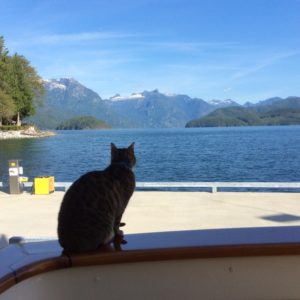
ZuZu always liked the view from the highest vantage point she could get to. One of her favorite spots was the cap rail on Flying Colours. In the top photo, we’re at Toba Inlet and she’s gazing off to the snow-capped mountains in the distance.
A Requiem To ZuZu (2004-2022). Every cruising year except one – 2008 when we went to SE Alaska on Cosmo Place, our 42’ Nordic Tug – ZuZu has been our faithful boat cat. Although she hated almost every minute of being on the boat, she put up with it and cruised along with us like a trooper. ZuZu was an indoor/outdoor cat, and always wanted to be outside when on the boat – jumping onto the dock and going walkabout every chance she got. We’d take her for dock walks on a lead, but that wasn’t enough – she wanted to go exploring on her own.
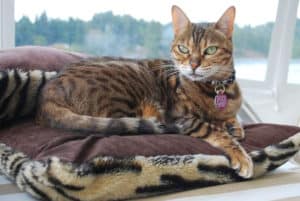 ZuZu is in a better place now – having quietly gone out our pet door at home one night in April and didn’t return. There’s a small possibility that a predator got her that night (coyote, raccoon, eagle), but we believe she knew it was her time and curled up under a secluded shrub on our property and laid down to die – on her own terms, which is really fitting with her personality. We miss her terribly, particularly on this year’s cruise . . . when we think she’s just jumped up on the bed in the middle of the night, or when we’re in rough seas (which she hated), or when a noise reminds us of kibbles rustling in her food bowl as she ate. Thanks, ZuZu, for giving us 18 wonderful years of your life.
ZuZu is in a better place now – having quietly gone out our pet door at home one night in April and didn’t return. There’s a small possibility that a predator got her that night (coyote, raccoon, eagle), but we believe she knew it was her time and curled up under a secluded shrub on our property and laid down to die – on her own terms, which is really fitting with her personality. We miss her terribly, particularly on this year’s cruise . . . when we think she’s just jumped up on the bed in the middle of the night, or when we’re in rough seas (which she hated), or when a noise reminds us of kibbles rustling in her food bowl as she ate. Thanks, ZuZu, for giving us 18 wonderful years of your life.
Remember, you can click on any photo to enlarge it (and then use your Back button to return to the blog text.
(In an earlier blog post I did a tribute to Gator (AKA registered name, Emerant’s The Instigator) – June 26, 2017, titled Traveling With Pets. As with Zuzu, and with Raz a few years earlier (a beautiful tri-color Basenji you see in my earlier blog posts), losing a longtime friend and pet is extremely difficult. At this point, we just have Jamie on board – our 10-year old Basenji who is the daughter of Gator. She too is an incredible boat pet, and we really enjoy cruising with her.
Getting Away From Anacortes. An often-expressed sentiment from people who spend time on their boat is, “the worst day on the water is better than the best day on land”. That’s obviously a blustery overstatement, as well as an excuse to justify time away on the boat (and the money you’ve spent on it). In fact, it’s simply not true. This summer of 2022, we’ve had some pretty bad days on the water, and the fingers on two hands are needed to count the number of times Kap and I have looked at each other and said, “is it time to just give up on this summer’s cruise and head for home?”. Each time we quickly got over it and stuck with our cruising plan. But each time the sentiment was tempting.
A large part of the problem has been mechanical and electrical cobwebs that grew from keeping Flying Colours in her covered slip at Anacortes from Fall 2019 to June 2022, adversely affecting several of the boat’s systems. But those cobwebs also seeped into our own brain crevices and muscle memory, creating a surprising impairment for us too. For Flying Colours, living in salt water is definitely hard on all the systems, but so is inactivity. It also doesn’t help that Flying Colours is now over 13 years old, with 1,300 hours on her engines, hull, and systems. And while she is in pristine condition, some things are nearing their life’s end. And in the fairly remote waters we cruise in, when things break and we lave lapses in our memories, it certainly adds to the challenges.
I’ll get to some of those challenges as I’m writing this post.
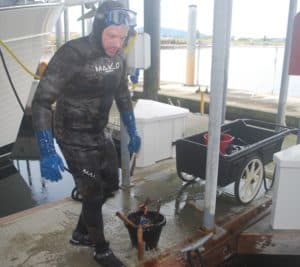
Jeff, of Underwater Diving Services and one of our two resident divers at Anacortes Marina, is ready to “dive on Flying Colours” at our slip on the day before our departure. We had a very thick “beard” of seaweed at the waterline of the boat that he cleaned off, and a thick scum of algae all across the bottom that would get washed off as we cruised – but more importantly, our protective – and sacrificial – zincs scattered around the boat’s exterior needed replacing. If the zincs aren’t replaced and wear to nothing, any stray electrical current in the water starts to attack all of the conductive metal on the boat (props, shafts, engine parts). It costs about $700 for Jeff to replace all of the zincs, but this is peanuts compared to the huge costs of replacing boat metal parts.
Preparations. This was an unusual year. Over the winter we decided to upgrade our navigation software and pilot house/fly bridge monitors that display course plotting, depth of water below our keel, and radar output. After years of pussyfooting around the decision, we also decided to swap out our satellite antenna and upgrade our Apple TV devices and other entertainment “boxes”. As usual, everything related to these tasks was stretched out and took much longer than expected, with the work going on right up to the day before departure. Which also meant we didn’t get a chance to actually use any of this on our planned shakedown cruise before the main summer cruise. We also didn’t get our promised “cheat sheets” from our installer on how to use all of the stuff (user guides can never tell you how to use component hardware/software that has to “talk” with various other hardware/software).
As I write this, we’re now two months into the cruise, and we are still dealing with issues across all of the changes. Frustrating! We’re also finding that “things” that worked yesterday don’t work the next time we fire them up, and sometimes they suddenly work an hour later with no changes from us.
What we learned? After work of almost any kind is complete, a shakedown cruise is vital – and it must be one that approximates what/where you’re going on your main cruise.
Departing Anacortes, June 15. We pulled out of Anacortes two weeks later than we hoped – and that always leads to a rushed feeling that the summer cruise was already going to pot. But we weren’t expecting to return home until early- to mid- September, so it isn’t a big deal.
The Big Gulp! First task was to top off Flying Colour’s diesel tanks. Knowing that diesel was already very expensive in the U.S – what would it be in Canada? Before leaving Anacortes, we stopped at the Cap Sante Marina fuel dock next door to our marina and got the question answered – $5.98/gal in the U.S. – versus what we later found to be US$7.44 in Canada.
We have four large fuel tanks, totaling 1,000 gallons, but we’d put the boat to bed back in 2019 with the tanks almost full – the biggest fuel draw during the two+ years was to run the diesel heater to keep the boat from freezing up in the winter. All told, it took 301 gallons to fill the tanks, and the bill was $1,999.15. Yes, that’s a big gulp – but when all the tanks are low we’ve seen it pushing $5,000 for a full fill-up.

Flying Colours is at the lower right of this heavily cropped photo taken from the top of the dock ramp at the Port of Friday Harbor Marina. On the other side of the dock from us is huge barge carrying three full size houses on it. The houses were the result of a wealthy Vancouver businessman purchasing three adjacent lots, then loading the existing houses aboard this barge for shipment to somewhere in the San Juan Islands for new owners. We spent one night at Friday Harbor, then headed across to Sidney the next morning.
Short shakedown cruise to Friday Harbor. The plan was to do a short 3-hour shakedown cruise to the Seattle Yacht Club outstation at Friday Harbor, spend the night, then head over to Sidney (on Vancouver Island) the next day. But on arrival, every moorage spot on the docks was full. We called the Port of
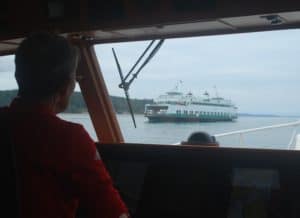
Kap at the helm and meeting a Washington State Ferry as we cruised to Friday Harbor on our first day on the water in over two years.
Friday Harbor marina and luckily they had room for us. Finding the outstation docks full felt like a bad omen, and we were concerned that, after all the local area cruisers had been locked in place for the past two years, maybe this summer would be hell on the water – every place crammed with boaters finally able to get away. We soon learned this was very true in fact.
Crossing Into Canada. The big unknown was . . . Canada Customs. We’ve used Nexus for the past 10+ years, where we just call Customs (Canada Customs when we’re crossing into Canada, or U.S. Customs when we’re returning), answer a few questions, jot down the clearance number, and Bob’s Your Uncle, we’re cleared in. Since Covid, everything you read gives a different opinion on what it now takes to cross into Canada, and even if you call Canada Customs directly you don’t get a straight answer. The consensus seemed to be, cross over to Sidney, head straight for the Customs dock at Port Sidney Marina, and it’ll be a face-to-face clearance, with boarding of your boat by a Customs agent almost a certainty. We were not looking forward to it – and assuming this was true, we had no idea if all the stuff we normally bring into the country would get us crosswise with Customs. The last thing we wanted to do was risk losing our Nexus cards for 5-10 years because of some screw-up (i.e., not reporting something in our possession and they later find it).
As we entered Haro Strait, with the U.S./Canada border running down the middle, I could see a large ocean freighter heading towards us from the south. From our many years of crossing shipping lanes, and knowing how fast these guys travel (at least 18, maybe 22 knots), discretion dictates that you don’t try to outrun them. I slowed to a crawl, then stopped where it felt safe from the wake he’d leave behind when he passed. Ahead of us were four other smaller (and stopped) go-fast motor yachts that we’d been following since passing Roche Harbor on San Juan Island. From their radio discussion it was obvious this was their first ever crossing to Sidney, and three of the skippers were rambling on about whether to shoot across in front of the freighter. One guy said, in obvious reference to his wife on board, “Sue doesn’t like freighters, so she votes to pour on the coals and get across in front of it”. Kap and I looked at each other in disbelief, as by now it was obvious they couldn’t make it in time. The idiots came to their senses and waited it out.
I figured that as soon as the freighter passed, they’d shoot on ahead and slow us down at Canada Customs. To our surprise, after the freighter passed, all four of them lagged behind, and even though we were only doing 8–9 knots, they slowly fell further and further behind us. By the time we approached Port Sidney Marina, they were at least 10-15 minutes behind us.
Outside the Port Sidney Marina breakwater we saw a couple of boats already milling around and figured that must be the start of a queue for the Customs dock. How it worked, though, we hadn’t a clue, as the large rock breakwater was too high to see over. The next minute explained it, as a young guy from the marina, on the marina radio frequency 66A, told these two boats that with one boat already on the Customs dock, they were first and second in the queue. We made Flying Colours known to him, and he said we were #3 in the queue.
Not long afterwards the four boats from our passing freighter episode arrived and they too were added to the queue, plus another two boats arrived shortly after them. We now had nine boats in the queue – and the queue outside the breakwater wasn’t moving. We all bounced around, minute after minute, until more than an hour had gone by. It was impossible to know what was going on at the Customs dock, so we had no choice but to sit it out.
Finally, after almost two hours the two boats ahead of us were notified by the Port Sidney Marina guy to proceed to the Customs dock. It was now almost 3PM. Again, we waited and waited, growing more and more frustrated. In the meantime, the four freighter incident boats who came in after us queried the Port Sidney Marina guy about what was going on – and to our surprise he suggested they might want to consider motoring to the Van Isle Marina just a mile to the north to see if they could more quickly get into the Canada Customs queue there. They must have talked it over on their cell phones as we didn’t hear anything, and the next we knew all four of them headed towards Van Isle. To add insult, before our own call came in to head for the Customs dock, we heard on the radio that the four boats had successfully cleared at Van Isle.
Within a minute or two of that, we got the call to motor through the breakwater and head for the Customs dock. When we arrived, one of the two boats ahead of us moved away from the Customs dock and we slid in and took his place.
Expecting to be a boarded for a face-to-face clearing with Canada Customs, it was a huge surprise there were no Customs agents at the dock at all – and instead, the clearance interview was to be by cell phone – which is exactly how we’ve always cleared for Nexus, when the call was made as we crossed the border and without the multiple hours-long wait.
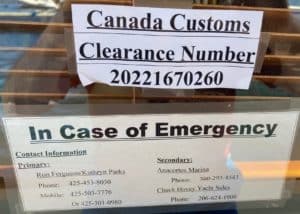
The Canada Customs Clearance Number must be displayed on the window while Flying Colours is in Canada.
We then learned that the boat still on the dock had arrived knowing nothing about the ArriveCan phone app that has to be filled out and submitted to Canada Customs at least 36 hours prior to arrival, and they were now in the process of going through that in real time.
Inside the ArriveCan app, you provide all of your visiting information – arrival/departure dates in Canadian waters, your basic itinerary, passport/Nexus numbers, personal information, your boat information, how much alcohol you have on board (experienced boaters know to tell them you have “our normal ship’s stores” on board and that has worked well for us for 10 years) – and the all-important Covid vaccination QR thingy.
I called the Customs number, and was connected to someone who I believe was probably a Nexus agent working from home due to Covid. After answering the familiar questions, and within 10 minutes, we were cleared and given our Canada Customs Clearance number to post in the window of Flying Colours. There was no inspection, there were no questions any different from regular Nexus processing – and no need to worry about being over any limits or with goods that aren’t allowed. I had worried for naught (and had left a bunch of things behind in Anacortes that I didn’t want to risk our Nexus card over).
Taking Care of Sidney Business. There were several crucial tasks on our list for Sidney – (1) look into repair of our davit (the motorized crane on the fly bridge deck that’s used to raise and lower the dinghy; (2) recertify (and fill) an expired BBQ propane tank or purchase a new one; (3) provision with fresh galley items that aren’t allowed across the border; (4) get a rental car and drive down to Victoria to stock up on some very favorite popcorn from a shop called Kernels that Kap really likes, and (5) lunch/dinner at our favorite Sidney restaurant – the nearby Stonehouse Pub in Canoe Cove.
Task #1 proved far easier than we expected. We were braced for taking Flying Colours over to the Van Isle marina area where Delta Marine is located (the Fleming warranty yard in Sidney) and then spend several days while the problem was worked on. Instead, when we drove over for lunch in a rental car, we were surprised that two davit expert technicians were dispatched to follow us back to Port Sidney Marina to look at our problem. In less than 10 minutes they had sorted out the problem – and then helped Kap with some tutorial training on our new navigation software that she was having problems with.
Task #2 was equally easy. One of the guys from Delta Marine knew of an obscure propane service company located halfway between Sidney and Victoria where an old guy at his residence runs a 3-person company called Vancouver Island Propane Services – and he was known to certify U.S.-inspected propane tanks with a new B.C. certification – which no one else will do.
The background on this – in brief. We discovered the day before departure that the tank test certification on our two pony beer keg-sized propane tanks on Flying Colours had expired in 2019. To hold off departure now would cost us at least a week, maybe two weeks – but with the tanks out of certification, no one in Canada will fill them. We thought the likelihood of both tanks being full was high, and if so, they would last through the summer. But on our first boat dinner at Friday Harbor, when Kap lit the BBQ from the tank that was still hooked up to the hoses, it fizzled empty in less than five minutes (from use on our last cruise, in 2019). Not giving in to the situation, we figured the other tank was still full, and if we could just get over to Delta Marine in Sidney we could buy a replacement tank. Not so – these tanks are specialty RV tanks, expensive, and hard to find. After hearing that, we headed for the Vancouver Island propane guy, and sure enough he said he’d get the empty tank certified and back to us by next Wednesday (five days from now – leaving the question, what would we do for those five days?).
Task #3 is an old standby on every trip to Sidney – provisioning. Sidney has been our standard provisioning stopover – to pick up all of the food items we can’t bring across the border – fresh fruits and vegetables, topping off our wine, spirits and liquor cabinet supply, and a lot of fresh meat that we don’t want to have confiscated if Canada Customs gets frisky. Over the course of trip after trip to the store, it’s a wonder flying Colours will float after we load up the galley fridge/freezer, a built-in freezer in the boat’s cockpit, and a very large ice chest that we carry on the dinghy deck.
Task #4 is our most pleasurable – lunch at Stonehouse Pub in nearby Canoe Cove. It’s very close to the Fleming maintenance facility, Delta Marine, and we always combine lunch there with whatever business we have to do at the marine yard – this time to see about the davit work. But once at the pub we were disappointed to find they had taken their excellent BBQ pork ribs off the menu due to pandemic-induced difficulty in sourcing them. They still had their excellent appetizer of Sambucca Prawns (a boat dish full of broiled prawns smothered in a Sambucca butter sauce), and Coconut Prawns – both of which we basically made a meal of in the absence of BBQ ribs.
Quick Trip To Ganges. The best use of our time for the 5-day wait for our propane tank fix was to pop up to Ganges to get some things done there. There are some good things to do in Ganges, most involving food (and it used to be our primary wine provisioning spot). Before I talk about that, though, a tidbit about the past history of Salt Spring Island might be in order.
Vietnam Draft Dodgers. Between 1965 and 1975, when the Vietnam War military draft was in full swing in the U.S., the government estimates that upwards of 40,000 draft-aged U.S. males fled across the Canadian border to evade the draft – about a quarter of them to British Columbia. The reason? The Canadian government labeled draft dodgers as immigrants, rather than refugees – and didn’t refuse them entry, arrest them, or send them back home.
At the time, Salt Spring Island was already a hippie haven, and those trying to escape the draft fit right in. Roughly half stayed after the war. A pardon was granted to draft dodgers and military deserters in 1977 by President Jimmy Carter. (In 2007 during our first summer’s cruising, and before I knew anything about this, I visited a chiropractor in Ganges for a serious back pain issue that had cropped up out of nowhere. In the course of treatment he mentioned that he was a U.S. draft dodger who came to Ganges in 1970 – and wouldn’t live anywhere else.) One Canadian government report stated that those who stayed make up “the largest, best-educated group this country ever received” – a very high percentage of the draft dodgers were college educated and highly intelligent war protesters that resulted in a brain drain from the U.S. to Canada.
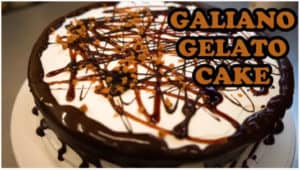 What’s So Special For Us About Ganges? Well, first and foremost is a gelato cake that we get at an ice cream shop called Harland’s. It’s made at a “factory” called Salt Spring Gelato on the outskirts of Ganges (and supplied to four or five ice cream shops around the Gulf Islands). This multi-layer gelato cake (Kap calls it a pie, as that’s more the shape and size of it), called the Galiano Cake, is Kap’s favorite – they have 10 different versions of gelato cake. On their website is a YouTube video that shows, step-by-step, how it’s made – at https://www.youtube.com/watch?v=U5cASdrnqP8&list=PLRzPoAgXPXgHJMrYRHWGB881KchktENpV&index=4. It starts with an Oreo cookie crust, then a layer of Belgian chocolate gelato, followed by salted caramel slathered on, then a layer of whipped cream all around to frost it, a layer of dark chocolate syrup to decorate it, and a final sprinkling of toffee bits. Kap always orders it 2-3 days ahead of our arrival to ensure one is available at Harlans and her first task is to pick it up and bring it back to Flying Colours. There, she cuts it into about eight pie wedges, wraps each in a good layering of Saran wrap, and freezes it. Throughout the cruise, the gelato cake will be in our dessert rotation. At cruise end, a return trip to Ganges is made, to get a Galiano cake to take home.
What’s So Special For Us About Ganges? Well, first and foremost is a gelato cake that we get at an ice cream shop called Harland’s. It’s made at a “factory” called Salt Spring Gelato on the outskirts of Ganges (and supplied to four or five ice cream shops around the Gulf Islands). This multi-layer gelato cake (Kap calls it a pie, as that’s more the shape and size of it), called the Galiano Cake, is Kap’s favorite – they have 10 different versions of gelato cake. On their website is a YouTube video that shows, step-by-step, how it’s made – at https://www.youtube.com/watch?v=U5cASdrnqP8&list=PLRzPoAgXPXgHJMrYRHWGB881KchktENpV&index=4. It starts with an Oreo cookie crust, then a layer of Belgian chocolate gelato, followed by salted caramel slathered on, then a layer of whipped cream all around to frost it, a layer of dark chocolate syrup to decorate it, and a final sprinkling of toffee bits. Kap always orders it 2-3 days ahead of our arrival to ensure one is available at Harlans and her first task is to pick it up and bring it back to Flying Colours. There, she cuts it into about eight pie wedges, wraps each in a good layering of Saran wrap, and freezes it. Throughout the cruise, the gelato cake will be in our dessert rotation. At cruise end, a return trip to Ganges is made, to get a Galiano cake to take home.
The 2nd order of Ganges business is why our stay always must be at least two nights – dinner at Auntie Pesto’s one night, and House Piccolo restaurant the other night. I did a special coverage of both restaurants in my June 24, 2019 blog post, Summer 2019 Cruise – Sidney, Ganges, and Garden Bay, so I’d only be repeating myself if I did it again. Dinner at both places was again worth the trip to Ganges.
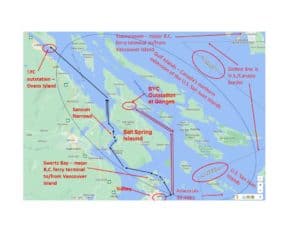 Cruise To Ovens Island. After our Ganges business was complete, we made a quick trip back to Sidney, collected the propane tank, and then continued our cruising north – with plans for an overnight stop at the tiny, secluded – and private – SYC outstation at Ovens Island (near Ladysmith).
Cruise To Ovens Island. After our Ganges business was complete, we made a quick trip back to Sidney, collected the propane tank, and then continued our cruising north – with plans for an overnight stop at the tiny, secluded – and private – SYC outstation at Ovens Island (near Ladysmith).
As you can see on the annotated map at left (which I readily admit has far too much detail, and absolutely needs to be enlarged to make any sense out of it) –Sidney is at the bottom middle and Ovens Island is at the upper left. I pointed out the B.C. Ferries terminal at Tsawwassen, which is 20 miles south of Vancouver, so this illustrates just how far the U.S./Canada border drops south as it wraps around the southern end of Vancouver Island.
Shown in black lines on the left half of the map, our route north from Sidney skirted around the west side of Salt Spring Island. With the current running in our favor (i.e., flooding to the north, it gave us a “push” of 3-4 extra knots speed through the swirling waters of Sansum Narrows. We consider this “the back way” to Ovens Island, and from Sidney it’s probably the shorter route by a small bit. From there it’s a straight shot to the NW to Ovens Island.
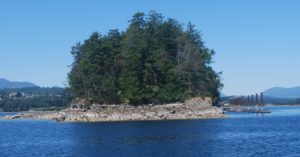
The photo shows just how small the Ovens Island outstation is – maybe 200’ wide, and 1,000’ long, with dock space – that you can see on the right when you click on the photo to enlarge it – for about 10 SYC member boats – depending on boat length.
Ovens Island and On To Garden Bay.
Just after midday we tied onto the completely empty dock at the secluded SYC Ovens Island outstation. We always hope for it to be empty, as the seclusion is exactly what we’re looking for. A month later, the dock that you see on the right of the photo will be completely full, cruisers taking a stroll around the island for exercise on a rugged trail, kids playing on the island, and lots of dog walking. Now, though, we knew we’d have it all to ourselves.
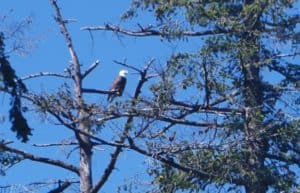
Because their squeaky call is so unmasculine for such a majestic bird, we can always tell when an eagle is in the area. We have always listened carefully for this to ensure that ZuZu wasn’t about to be grabbed up as lunch. This one was in a tree just above us on the dock at Ovens Island. We never tire of looking at eagles in the wild.
As idyllic as Ovens Island is, there’s an undercurrent of trouble ahead for the SYC’s ownership of it. The SYC originally purchased the island about 20 years ago from the First Nations band that lives along the shore to the right of the photo, and for some reason a group within the band have now decided they don’t want to honor the sale, and are beginning to exhibit their perspective (remember, “band” is the First Nations term that we call a “tribe” in the U.S.). If you look closely at the photo (enlarged), you can make out an aluminum boat at the inside far end of the dock. It had paint markings on it indicating it was once a scuba diving boat – and not knowing if someone was trespassing on the SYC’s property, I called the outstation manager to let him know. He indicated, yes, he was aware of the boat being on the dock, and that it’s owned by an elder member of the band who was given permission to moor the boat there over the winter months (when the SYC isn’t using Ovens at all) – with the stipulation that he had to remove it by May 1 when our members would be arriving. Well, here it was now almost the beginning of July and the boat was still here – and our outstation manager said that the band elder seemed to be backing out on his agreement – maybe as a way of defying us. Also, later in the day a canoe with two young First Nations guys in it showed up at the opposite end of the dock from us, got out with fishing poles and dropped their hooks into the water off the dock. They certainly weren’t causing any specific problem, but their presence was definitely trespassing on property that is clearly marked as private and for the use only of SYC members. When we later mentioned this to an SYC member “in the know”, he said these two boys show up almost every day, again as a way to show defiance of our ownership of the dock.
After a quiet and peaceful night, we departed Ovens Island at noon the next day, timed for the slack at Gabriola Passage and our transit across the Strait of Georgia – headed for the SYC outstation at Garden Bay (in Pender Harbour near the top of the beautiful B.C. Sunshine Coast. With extra time to spare before slack, we dawdled along at 7 knots, enjoying a bright summer-like sky and a moderate temperature. From a recent spring tide – which always pulls stray logs off the beach at high tide – we had to watch carefully for an abundance of logs in the water.
We’ve had one or two “exciting” rides through Gabriola, when we got antsy and decided to tempt fate by entering the tricky and S-curvy passage. It taught us not to do it again. This time, as we approached the bay on the west side of Gabriola Passage, Kap let out some expletives with the news that our new navigation software was having problems – the screen image jumping up and down every 1-2 seconds, the boat icon that indicated our position on the screen was frozen, and we had no depth indications. After fiddling for 10 minutes to see if she could resolve it, she turned 180 degrees to head for safer water. We then called our technical contact at Delta Marine in Sidney to see if he could help troubleshoot – and sure enough, within about a minute he concluded that the main PC behind all of our navigation software needed to be rebooted, as it had somehow lost access to our GPS satellite antenna. That solved the problem and we turned around to head a second time for Gabriola Passage – totally pissed that this again was one of those situations where the new upgrades made in the spring were not proving reliable.
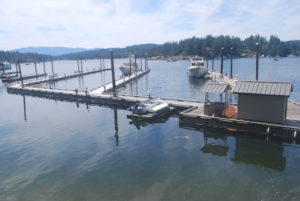
A day later, most of the boats on the dock headed either north to Cortes Bay, or west across the Strait of Georgia on their way south, leaving only us and Couverden on the docks for a day or two before it began filling up again.
Once through Gabriola Passage we set a diagonal course across the Strait of Georgia for the SYC Garden Bay outstation in Pender Harbour on British Columbia’s wonderful Sunshine Coast, on the mainland and north of Vancouver. All was right with the world – the Whiskey Gulf (WG) Canada/U.S. navy’s joint underwater torpedo test range was “not active” and we could transit right through it. There were no B.C. Ferries to harass us on their course from Nanaimo to Vancouver. And the water all the way across the Strait was quite benign.
We arrived at Garden Bay at 6:30PM – the Strait of Georgia is 15 miles wide at its narrowest point and 135 miles long, and our transit to Garden Bay on a diagonal course was around 40 miles. There were 3-4 other boats, including our first meet-up with our cruising friends, Steve and Andrea (Shirley) aboard Couverden, a Fleming 55 similar to Flying Colours.
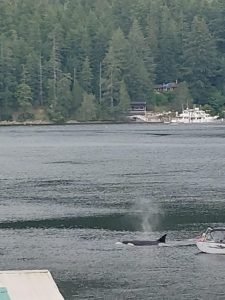
One day I received an e-mail from Vicky, the SYC full-time outstation manager, attached with this photo from the local newspaper, the Coast Reporter. It was taken the day before of an Orca surfacing and blowing just off the dock at Madeira Park, the small village across the bay where we go by dinghy to shop for groceries and spirits. In the far background is Flying Colours on the dock at the SYC outstation, with a slight glimpse of Couverden behind us. The SYC clubhouse is to the right of the photo – the house behind Flying Colours was where our famous neighbor, Edith Iglauer – author of articles for The New Yorker magazine, and the book, Fishing With John that was made into a move titled Navigating the Heart (2000) – and not to be confused with the TV miniseries of the book’s name of 1991. Ms Iglauer died in 2019 just shy by two weeks of her 102nd birthday.
I’ve covered the Garden Bay outstation in great detail on previous blog posts, and won’t do so again – except to say that we had a very good seven day R&R visit here.
A/C Failure. So far on this cruise the weather had been unseasonably cool – never getting above the mid-high 60° mark – all the while we were hearing about scorching temps in the rest of North America. Then suddenly, we got two days in the 80’s and we were in misery – due to one of our air conditioning zones going out. We have a system called CruiseAir on board, and it has a control unit that feeds cool air to the salon/galley, another control unit to the pilot house (where we drive from), and a third and fourth to our master and guest staterooms – each controlled by a wall-mounted thermostat. Well, as luck would have it, the control unit for the most important one – the master berth – failed on those hottest of days. It was absolutely miserable at night. Kap tried everything, including swapping out the thermostat from the guest to the master stateroom, but with no success. A call to our tech guy in Sidney the next day gave us some troubleshooting that narrowed the problem down to a circuit board on the master stateroom control unit in the lazarette. The recommended solution was to swap out the circuit board for the guest stateroom for the one in our master stateroom. But Kap didn’t feel comfortable doing that herself – as her last experience with working on a circuit board was with our WhisperGen, and a screwdriver “touch” to a mounting nut had shorted out the whole board, frying our whole control unit. We decided to track down a mechanic/electrician in Campbell River, and make that our next stop after Cortes Bay.
Garden Bay to Cortes Bay. When we departed Garden Bay a week later, the outstation was completely full with SYC boats, and it was obvious that the summer rush of cruisers from Seattle had begun – and maybe more so, this being the first year of the U.S. Canada border being open since early 2020. We were not overjoyed at what we might find at the Cortes Bay outstation, as this is the crown jewel of SYC outstations, being the “gateway” to the incredibly popular Desolation Sound area.
Nevertheless, Kap timed our departure at 1PM to catch the best current that would give us a push along Malaspina Strait for the 5-hour, 50 mile cruise northward. The only real town we’d pass on this leg would be Powell River – about midway. This city, with a population of just over 13,000 is an old (early 1900s) pulp town and built around the largest “pulp and paper mill in the world . . . in its prime, one in every 25 newspapers in the world was printed on paper from the Powell River mill. However, since then it has significantly cut back on production” (quoted from the Wikipedia article on Powell River). The only serious hazard to watch for along the route is the hourly passenger/car ferry from Powell River across the Strait of Georgia to Comox on Vancouver Island.
Nothing new to write about for the Cortes Bay outstation. We had a quiet and relaxing stay of 10 days, moored at our favorite dock spot at the end of the main dock, tied stern out so that we could sit in the cockpit over cocktails and look out over the bay – and simply didn’t do much. Along the way the outstation filled to capacity, and the last night there we had to accept another SYC member who “rafted” – tied alongside us – which is an SYC requirement at all outstations when they’re full.
Side Jaunt To Campbell River. On 10AM on July 10th, we departed Cortes Bay for the 2-hour run over to the Discovery Harbour Marina at Campbell River to have our A/C circuit boards swapped. Our tech friend at Delta Marine in Sidney had arm twisted a guy he knew at Ocean Pacific Marine boatyard in Campbell River to relent on his claim of no time open in their schedule until late August! He agreed to send a guy down to the docks the morning after our arrival to make the switch.
True to their word, as 10AM the next morning the shop electrician was aboard Flying Colours. He was a big guy, and how he squeezed into the tight confines of our lazarette is beyond me – but he did, and within an hour he had the boards swapped. Kap started the A/C unit in the master berth, and it worked like a champ. (Did I mention that more things seem to be going wrong on our cruise this year? Stay tuned.)
Besides the A/C fix, the other highlight of being in Campbell River was dinner at the Harbour Grill. It overlooks the marina we were staying at, only a hundred feet from the dock ramp where we were moored. In a modest setting, they offer a classic French Onion soup, along with my favorite, a New York Steak au poivre with a green peppercorn/cognac/cream sauce. It doesn’t get much better than that for me.
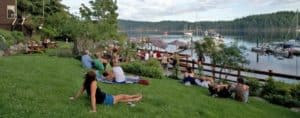
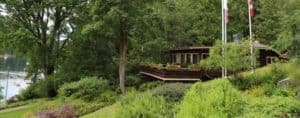 Gorge Harbour – our next stop after Campbell River. We slipped our moorage lines Campbell River on Wednesday, July 13th for the relatively short two-hour cruise across the top end of the Strait of Georgia to the tucked-away inlet accessible via a narrow steep-walled gorge entrance. We had a 2-night moorage reservation, with a primary plan to have dinner one night at the Floathouse Restaurant – and yes, it’s named that because the restaurant building is an old float house that, having finished it’s previous life as a floating home somewhere in the area, was hauled a couple hundred feet up the hillside, and with the float logs still visible beneath it, turned into a great restaurant (pictured above). We always have a great meal here – Kap typically has their salmon special and I always have the striploin (what we call a NY steak in the States).
Gorge Harbour – our next stop after Campbell River. We slipped our moorage lines Campbell River on Wednesday, July 13th for the relatively short two-hour cruise across the top end of the Strait of Georgia to the tucked-away inlet accessible via a narrow steep-walled gorge entrance. We had a 2-night moorage reservation, with a primary plan to have dinner one night at the Floathouse Restaurant – and yes, it’s named that because the restaurant building is an old float house that, having finished it’s previous life as a floating home somewhere in the area, was hauled a couple hundred feet up the hillside, and with the float logs still visible beneath it, turned into a great restaurant (pictured above). We always have a great meal here – Kap typically has their salmon special and I always have the striploin (what we call a NY steak in the States).
Eating Well During Our Summer Cruise. As part of our departure preparations, we packed the two freezers and a very large ice chest on board Flying Colours chock full of pre-prepared dinner/lunch items – Tandoori chicken/butter sauce/rice for an authentic Indian-style Butter Chicken, all the fixin’s I need for steak au poivre and Steak Diane, ten NY strip steaks (me) and ten beefalo tenderloin steaks (Kap) on the BBQ, pork schnitzel (Kap) and cordon bleu (me), a very special Kümmel Chicken dish, chicken sate with a Thai peanut sauce, a great spaghetti that Kap makes, and several shrimp dishes that feature the shrimp we’d pull up later in the cruise. And then favorite restaurants at various places we’d stop at.
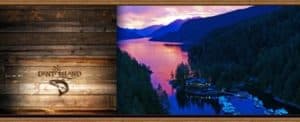
This sunset photo was cadged from the Dent Island website, looking up Cordero Channel towards Blind Channel.
Gorge Harbour to Blind Channel Resort. From the Desolation Sound area, many cruisers heading to The Broughton’s will overnight at the Dent Island Lodge, a private luxury retreat that was built as a fishing enclave by the Nordstrom family of Seattle “back in the day”. When the Nordstrom family discovered it wasn’t being used as much as it should be to justify the expense, they decided to turn it into a high-end commercial fishing lodge, upscale lodge restaurant, and a fleet of 26’ four-pack, go-fast fishing boats with fishing guides. Their website price list describes an all-inclusive 2-night package (per person) at C$2,100 (US$1,630), including all meals, liquor, and lodging, plus 16 hours of guided fishing. Moorage at the dock is over C$5/foot, which is more than 2x the cost at the next highest priced facility anywhere in the area. For non-lodge guests, the fixed price menu at the lodge dining room is C$140/person. We’re not skinflints, but an absolutely excellent meal for two at Gorge Harbour or Blind Channel is considerably less than the price for one person at Dent Lodge. We’ve stopped at Dent Lodge 3-4 times on the way north or south, but not for several years now – the clientele of the “big boats”, the ones over 85’, are just too hotsy-totsy for our tastes, and while the service at the lodge dining room is truly Nordstrom-style, the food hasn’t been all that great the past couple of times. So, no, we didn’t stop here on our trip north this time, but instead, passed it by and continued on to Blind Channel Resort about eight miles further on Cordero Channel.
I wrote an extensive blog report on Blind Channel way back on July 8, 2011, titled April Point to Blind Channel, https://www.ronf-flyingcolours.com/2011/07/april-point-to-blind-channel/, so it doesn’t make sense to repeat it here. Suffice it to say that we enjoyed an excellent dinner at the Cedar Post Inn – salmon for Kap, and their excellent schnitzel for me – and were treated like old friends by the 3-generation owners and the staff that we’ve known from the past.
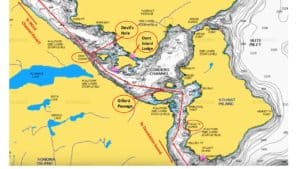 One more detail on this leg of the journey – the three “rapids” that you have to transit, Yuculta Rapids, Gillard Passage, and Dent Rapids are “serious” stretches of water that you absolutely must respect. All three are passageways that are narrow, and a full flood or full ebb tidal flow here sets up these rpaids. They aren’t at all like the wild and roiling rapids that you see thrill-seeking kayakers going through, but rather are powerful eddying currents that result from relatively shallow underwater features when the water flow is also restricted by narrowing. It’s really hard to explain, and even more difficult to visualize with a photo, so I suggest that you go to a YouTube video of the Yuculta Rapids at full flood (or ebb), at https://www.youtube.com/watch?v=hVlJTKTW6rQ. No one in their right mind would take a cruising boat like Flying Colours into these rapids at full flood or ebb. (This YouTube video was filmed from a go-fast fishing boat, and you should read the story about a Dent Island client on one of their fishing boats who got flipped into the Devil’s Hole at Dent Rapids, never to be seen again – in my blog post, Cortes Bay to Port McNeill, August 26, 2010, at https://www.ronf-flyingcolours.com/2010/08/cortes-bay-to-port-mcneill/.) The only safe way to traverse rapids such as these is at, or very close to, slack tide – and obviously these yo-yo’s who filmed this weren’t.
One more detail on this leg of the journey – the three “rapids” that you have to transit, Yuculta Rapids, Gillard Passage, and Dent Rapids are “serious” stretches of water that you absolutely must respect. All three are passageways that are narrow, and a full flood or full ebb tidal flow here sets up these rpaids. They aren’t at all like the wild and roiling rapids that you see thrill-seeking kayakers going through, but rather are powerful eddying currents that result from relatively shallow underwater features when the water flow is also restricted by narrowing. It’s really hard to explain, and even more difficult to visualize with a photo, so I suggest that you go to a YouTube video of the Yuculta Rapids at full flood (or ebb), at https://www.youtube.com/watch?v=hVlJTKTW6rQ. No one in their right mind would take a cruising boat like Flying Colours into these rapids at full flood or ebb. (This YouTube video was filmed from a go-fast fishing boat, and you should read the story about a Dent Island client on one of their fishing boats who got flipped into the Devil’s Hole at Dent Rapids, never to be seen again – in my blog post, Cortes Bay to Port McNeill, August 26, 2010, at https://www.ronf-flyingcolours.com/2010/08/cortes-bay-to-port-mcneill/.) The only safe way to traverse rapids such as these is at, or very close to, slack tide – and obviously these yo-yo’s who filmed this weren’t.
Actually, I have got a better one for you that you absolutely must see – a tugboat towing a barge through the Skookumchuck Narrows (just north of the Garden Bay SYC outstation). Why an experienced tugboat captain would take a loaded barge through these narrows outside of slack time is beyond me, but this guy did, and his very large tugboat rolled over in the rapids. The captain was saved by a kayaker who was with a bunch of thrill-seeking kayakers who come here for the standing wave that’s created at this narrows. You can see it at https://www.youtube.com/watch?app=desktop&v=QEfUblSDzww.
Blind Channel To Cullen Harbour (Outside Booker Lagoon). Our reservation for Blind Channel was for two nights, but before dinner on our arrival day, Kap listened carefully to the weather report on the radio and reached the conclusion that we should leave early the next morning. I quickly had our reservation changed, and after dinner we made all necessary preparations for an early morning departure.
Every weather indication was that we’d have fog on our trip up Johnstone Strait, which didn’t thrill us at all. But with the forecast for strong winds for the following three days – and against the current, which means rough seas – we didn’t feel we had a choice but to leave when we did.
At just after 6AM the following morning, when we pulled out into Mayne Passage from Blind Channel Resort, though, the skies were patchy with clouds and no sign of fog. In fact, we didn’t see any fog all day, which pleased us greatly. And another lucky factor – the wind was with us all the way, so we had a bit of a push for the long, six hour slog north on Johnstone Strait.
At just after 12:30 noon we arrived at Cullen Harbour (outside Booker Lagoon), Kap had calculated slack on the lagoon entrance at 2:30PM, and after nosing into the passage and seeing that the current was still running pretty strong, we decided to anchor for a couple of hours in Cullen to wait it out. With a blow expected for the next day, we contemplated staying put in Cullen and going in and out of the lagoon with the dinghy to set/pull our prawn pots, but after kicking the idea around we decided to go into the lagoon and stay there.
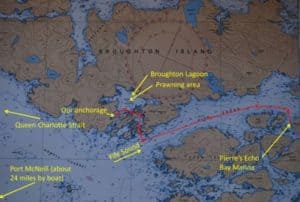 The next morning when we transited the entrance at slack tide, we were somewhat surprised to find the lagoon completely empty of boats, although there was a single prawn pot buoy that must have been from one of the boats anchored out in Cullen.
The next morning when we transited the entrance at slack tide, we were somewhat surprised to find the lagoon completely empty of boats, although there was a single prawn pot buoy that must have been from one of the boats anchored out in Cullen.
Kap headed straight across the lagoon to a small bay on the north side. (Note: The chart at left of Booker Lagoon was from an earlier post of July 20, 2011, titled Prawning in Beaver Inlet and Booker Lagoon, at https://www.ronf-flyingcolours.com/2011/07/prawning-in-beaver-inlet-and-booker-lagoon/. ) On this current visit, instead of arriving from Pierre’s Echo Bay Marina as the annotated chart shows, we came in from the SW (lower left corner) on Johnstone Strait. And instead of anchoring in the west bay, we anchored on the north side, directly across from the entrance. Cullen Harbour is the blue water behind the red line snaking into Booker Lagoon. We had never anchored in this area, and Kap thought it might be an easier location to take Jamie for her thrice-daily trek ashore for her “bidness” (turned out not to be true at all).
We set our anchor in 40’ of water, and started to settle in for what we hoped would be a week of good prawning. We also patted ourselves on the back for a flawless anchoring, and importantly, a smooth setting of the snubber (a seemingly easy task, but with a couple of technicalities that always give us problems – we now have those worked out). For a good explanation of the snubber, you can read about it in a blog post on July 6, 2014, titled Roseanne Roseannadanna!, at https://www.ronf-flyingcolours.com/2014/07/roseanne-roseannadanna/.
In the waning afternoon of this first day inside Booker Lagoon, Kap decided there was too much work to be done to get the prawn pots set up and ready to put in the water, so we opted for an early Happy Hour instead.
Next morning Kap worked on the prawn pots and got the pot puller installed on the dinghy. Mid morning she announced that the motor on the pot puller wouldn’t run, which was a major problem, as there’s no way we can set and pull our pots in 300’ of water without the electric puller. We both looked things over six ways to Sunday, but no cigar. We concluded the small sealed motor that was now almost 10 years old had probably failed. After talking it over we decided there was nothing to do but pull up the anchor and head for Port McNeill where we could hopefully get it repaired or replaced at the large marine store in town.
Midday slack to exit the lagoon was coming up in an hour, so we needed to work fast. We hauled the dinghy up to the upper deck on Flying Colours, and brought in the snubber.
Next up was the anchor. Working with the handheld windlass control at the bow while Kap was at the helm to keep the boat facing in the direction the chain/anchor were on the bottom, I pulled in the muddy and seaweed covered chain that had been our 3x “scope”. At 40’ remaining, the anchor should be leaving the bottom – but as I tried to lift it, the windlass motor groaned and slowed under a tremendous strain. I let up on it to give it a break, then tried again . . . and again. I figured the anchor was heavily imbedded in muck and mud on the bottom. Finally, it gave way and I could tell it had started to rise.
As the anchor reached the surface, I was horrified to see that it was also bringing up a large drum – about a 50 gallon-size drum (later I concluded it might have been a metal float used to create the net corral for the fish farm, and then sunk when the Atlantic salmon farm was torn out), When I saw the reflection of the anchor near the surface, I thought, “Holy shit – have I pulled up a large rock with the anchor?”, as it was gray and studded with barnacles. As it got to the surface, the weight of whatever it was simply brought the windlass to a halt. I called Kap forward to see it, but we were both too startled to take a photo of it.
What to do now?!!!! Running the windlass up and down a few times, I tried to shake the barrel off the anchor – but no success. I tried rapidly lowering the anchor a couple of times, but again, with no success. The anchor was indelibly stuck in the end of the barrel. I lowered the anchor back down to the bottom and let it sit there while we figured out what to do next.
We knew with this catastrophe that we’d miss the midday slack. Booker Lagoon is so remote that we had no cell coverage or internet access, and we didn’t think there were any other boats in the lagoon. What a helpless feeling.
But . . . I have a satellite phone that I purchase a low volume SIM card for each year just for such emergencies – and for making moorage and restaurant reservations when we’re off the grid. I spent the next hour calling to arrange some emergency support from a Canadian boating organization called VesselAssist – who have a reciprocal agreement with BoatUS that we have an emergency boat tow/rescue subscription with.
After we got assistance arranged, I decided to try lifting the anchor/barrel to the surface one more time. Kap got the engines started, and I worked the remote for the windlass/anchor. This time the chain came up almost entirely clean from mud, and with about 150′ of chain back on board, I could tell from the jangliness of the chain that all of the chain was off the bottom. At first, the windlass had to really work hard for the next few feet, but then it became easier. When the anchor reached the surface, the drum was gone! How it came free we’ll never know, but luckily it did.
We called off the rescue. With the chain up, we motored across the lagoon, and at the east end of the lagoon we found our old anchoring spot that we’ve used several times in the past, and settled in for a several hour wait for the next slack at 6PM. Late afternoon we then motored out through the lagoon passage and re-anchored in Cullen Harbour just outside Booker Lagoon to spend the night before we could head for Port McNeill in the morning. Whew! What a mis-adventure!
In the next post I’ll continue this saga of mis-adventures, as they didn’t stop here. Stay tuned.
Ron
